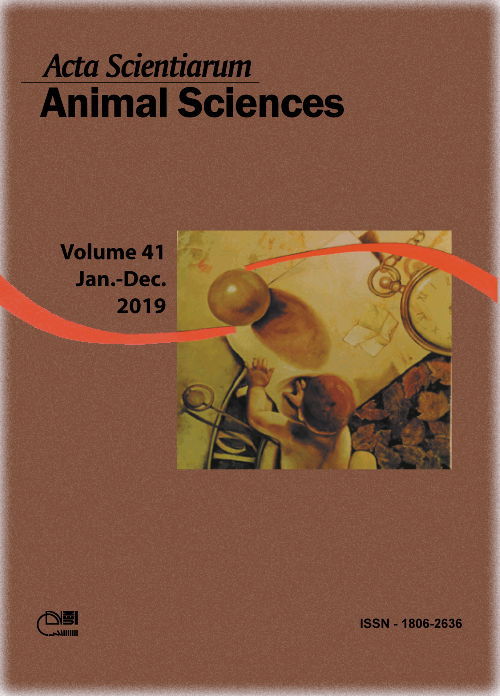Effect of inoculants combining Lactobacillus buchneri strain LN40177 in different strata of the silo
Resumo
The objective of this work was to evaluate the chemical composition and rumen disappearance rate of dry matter of corn silages with inoculants combining L. buchneri strain LN40177 in different strata of the silo. The experimental design was a 3x2 randomized complete block design, with three treatments: Control: corn silage without inoculant; 11CFT: corn silage with inoculant which combines L. buchneri strain LN40177 (1.1 x 1011 CFU g-1) with L. casei (1.1 x 1011 CFU g-1); and 11C33: corn silage with inoculant which combines L. buchneri strain LN40177 (1.1 x 1011 CFU g-1) with L. plantarum (1.1 x 1011 CFU g-1) and Enterococcus faecium (1 x 1010 CFU g-1), associated with two strata of the silo (lower and upper). The silage inoculated with 11C33 presented higher contents of crude protein and NDF and lower hemicellulose content in relation to the control treatment and 11CFT. The use of both inoculants resulted in silages with higher concentrations of soluble nutrients. Lower stratum silage had a higher rumen disappearance rate of dry matter compared to the upper stratum. In general, the combinations of L. buchneri promoted nutritional improvements in corn silage, but in presence of L. casei, there were more outstanding improvements.
Downloads
Referências
Association Official Analytical Chemist [AOAC]. (2005). Official Methods of Analysis (18th ed.). Gaitherburg, MD: AOAC International.
Goering, H. K., & Van Soest, P. J. (1970). Forage Fiber Analysis. USDA Agricultural Research Service. Handbook number 379 (16th ed.). Washington, DC: US Government Printing Office.
Lynch, J. P., Baah, J., & Beauchemin, D. K. A. (2015). Conservation, fiber digestibility, and nutritive value of corn harvested at 2 cutting heights and ensiled with fibrolytic enzymes, either alone or with a ferulic acid esterase-producing inoculant. Journal of Dairy Science, 98(1214-1224). doi: 10.3168/jds.2014-8768.
Marquardt, F. I., Jobim, C. C., Bueno, A. V. I., & Ribeiro, M. G. (2017). Altura de corte e adição de inoculante enzimobacteriano na composição químico-bromatológica e digestibilidade de silagens de milho avaliada em ovinos. Ciência Animal Brasileira, 18, 1-9. doi: 10.1590/1089-6891v18e-42888.
Muck, R. E. (2010). Silage microbiology and its control through additives. Revista Brasileira de Zootecnia, 39, 183-191. doi: 10.1590/S1516-35982010001300021.
Nocek, J. E. (1988). In situ and other methods to estimate ruminal protein and energy digestibility: a review. Journal of Dairy Science, 71(8), 2051-2069. doi: 10.3168/jds.S0022-0302(88)79781-7.
Nsereko, V. L., Smiley, B. K., & Rutherford, W. M. (2008). Influence of inoculating forage with lactic acid bacterial strains that produce ferulate esterase on ensilage and ruminal degradation of fiber. Animal Feed Science and Technology, 145, 122-135. doi: 10.1016/j.anifeedsci.2007.06.039
Oliveira, A. S., Weinberg, Z. G., Ogunade, I. M., Cervantes, A. A., Arriola, K. G., Jiang, Y., & Adesogan, A. T. (2017). Meta-analysis of effects of inoculation with homofermentative and facultative heterofermentative lactic acid bacteria on silage fermentation, aerobic stability, and the performance of dairy cows. Journal of Dairy Science, 100(6), 4587-4603. doi: 10.3168/jds.2016-11815.
Statistical Analysis System [SAS]. (2004). SAS/STAT User guide, Version 9.1.2. Cary, NC: SAS Institute Inc.
Silva, M. S. J., Jobim, C. C., Poppi, E. C., Tres, T. T., & Osmari, M. P. (2015). Production technology and quality of corn silage for feeding dairy cattle in Southern Brazil. Revista Brasileira de Zootecnia, 44(9), 303-313. doi: 10.1590/S1806-92902015000900001.
Tabacco, E., Piano, S., Revello-Chion, A., & Borreani, G. (2011). Effect of Lactobacillus buchneri LN4637 and Lactobacillus buchneri LN40177 on the aerobic stability, fermentation products, and microbial populations of corn silage under farm conditions. Journal of Dairy Science, 94(11), 5589-5598. doi: 10.3168/jds.2011-4286.
Van Soest, P. J., Robertson, J. B., & Lewis, B. A. (1991). Methods for dietary fiber, neutral detergent fiber, and nonstarch polysaccharides in relation to animal nutrition. Journal of Dairy Science, 74(10), 3583-3597. doi: 10.3168/jds.S0022-0302(91)78551-2.
Zanette, P. M., Neumann, M., Faria, M. V., Ueno, R. K., Marafon, F., & Durman, T. (2012). Valor nutricional e perdas durante a fermentação de silagens de milho (Zea mays l) com açúcar ou inoculante. Revista Brasileira de Milho e Sorgo, 11(2), 178-189. doi: 10.18512/1980-6477/rbms.v11n2p178-189.
Zopollatto, M., Daniel, J. L. P., & Nussio, L. G. (2009). Aditivos microbiológicos em silagens no Brasil: revisão dos aspectos da ensilagem e do desempenho de animais. Revista Brasileira de Zootecnia, 38, 170-189.
DECLARAÇÃO DE ORIGINALIDADE E DIREITOS AUTORAIS
Declaro que o presente artigo é original, não tendo sido submetido à publicação em qualquer outro periódico nacional ou internacional, quer seja em parte ou em sua totalidade.
Os direitos autorais pertencem exclusivamente aos autores. Os direitos de licenciamento utilizados pelo periódico é a licença Creative Commons Attribution 4.0 (CC BY 4.0): são permitidos o compartilhamento (cópia e distribuição do material em qualqer meio ou formato) e adaptação (remix, transformação e criação de material a partir do conteúdo assim licenciado para quaisquer fins, inclusive comerciais.
Recomenda-se a leitura desse link para maiores informações sobre o tema: fornecimento de créditos e referências de forma correta, entre outros detalhes cruciais para uso adequado do material licenciado.








































